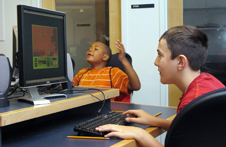Home > Press > Video game introduces youths to big ideas about a nano-sized world
 |
| A new online video game developed by Northeastern researchers is aimed at teaching youths the fundamentals of nanoscience and technology. |
Abstract:
Working on a science fair project with his lab partner Nikki, Harold Biggums finds himself transformed into a tiny superhero and flung into the midst of an alien plot to take over the world — a plot that he and Nikki can foil only by defying gravity, walking on water and charging across electric fields.
Video game introduces youths to big ideas about a nano-sized world
Boston, MA | Posted on February 17th, 2011This narrative dilemma is the basic storyline for Geckoman!, an online video game developed by Northeastern University researchers at the Center for High-rate Nanomanufacturing (CHN), which seeks to educate middle-school students about nanoscience and technology.
CHN director Ahmed Busnaina and associate director Jacqueline Isaacs led an interdisciplinary team of educators and game designers to develop the game, which is available in English and Spanish.
"Geckoman! is both engaging and challenging, and along the way, students pick up a lot of nanoscience fundamentals," said Busnaina, the William Lincoln Smith Professor of Mechanical and Industrial Engineering at Northeastern.
"We had excellent teachers working with us to develop four lesson plans that guide student learning," said Isaacs, a professor in the Department of Mechanical and Industrial Engineering. "The results of student play tests indicate that students are learning new concepts."
Game players follow Harold on an adventurous journey, after he has been shrunk to the nanoscale following an explosion in his laboratory. Players must navigate Harold through various levels across three different worlds, while also collecting scattered notebook pages that provide nanoscience tips to help him progress.
The game was created with funding help from the National Science Foundation; and 15 Days LLC, a company founded by Northeastern alumni and faculty, collaborated with CHN faculty on design. Staff members at Boston's Museum of Science helped match the game content to national and Massachusetts K-12 science standards.
How did the game get its name? Early in the game development process, the team worked on incorporating a key concept in nanoscience — the "van der Waals" adhesion force, which dominates other forces at the nanoscale. In fact, it is this force that enables geckos to run up walls; the pads of their feet have millions of nanoscale extensions. The game developers decided that Harold would have to become Geckoman, enabling him to move with greater ease between all the unusual surfaces he must navigate in addressing the game's multi-level challenges.
CHN, a National Science Foundation-funded Nanoscale Science and Engineering Center, is based at Northeastern University, with partners including the University of Massachusetts at Lowell, the University of New Hampshire, Michigan State University and the Museum of Science, Boston.
####
For more information, please click here
Contacts:
Greg St.Martin
617-373-5463
Copyright © Northeastern University
If you have a comment, please Contact us.Issuers of news releases, not 7th Wave, Inc. or Nanotechnology Now, are solely responsible for the accuracy of the content.
| Related News Press |
News and information
![]() Simulating magnetization in a Heisenberg quantum spin chain April 5th, 2024
Simulating magnetization in a Heisenberg quantum spin chain April 5th, 2024
![]() NRL charters Navy’s quantum inertial navigation path to reduce drift April 5th, 2024
NRL charters Navy’s quantum inertial navigation path to reduce drift April 5th, 2024
![]() Discovery points path to flash-like memory for storing qubits: Rice find could hasten development of nonvolatile quantum memory April 5th, 2024
Discovery points path to flash-like memory for storing qubits: Rice find could hasten development of nonvolatile quantum memory April 5th, 2024
Preparing for Nano
![]() Disruptive by Design: Nano Now February 1st, 2019
Disruptive by Design: Nano Now February 1st, 2019
![]() How nanoscience will improve our health and lives in the coming years: Targeted medicine deliveries and increased energy efficiency are just two of many ways October 26th, 2016
How nanoscience will improve our health and lives in the coming years: Targeted medicine deliveries and increased energy efficiency are just two of many ways October 26th, 2016
![]() Searching for a nanotech self-organizing principle May 1st, 2016
Searching for a nanotech self-organizing principle May 1st, 2016
Govt.-Legislation/Regulation/Funding/Policy
![]() NRL charters Navy’s quantum inertial navigation path to reduce drift April 5th, 2024
NRL charters Navy’s quantum inertial navigation path to reduce drift April 5th, 2024
![]() Discovery points path to flash-like memory for storing qubits: Rice find could hasten development of nonvolatile quantum memory April 5th, 2024
Discovery points path to flash-like memory for storing qubits: Rice find could hasten development of nonvolatile quantum memory April 5th, 2024
![]() Chemical reactions can scramble quantum information as well as black holes April 5th, 2024
Chemical reactions can scramble quantum information as well as black holes April 5th, 2024
Academic/Education
![]() Rice University launches Rice Synthetic Biology Institute to improve lives January 12th, 2024
Rice University launches Rice Synthetic Biology Institute to improve lives January 12th, 2024
![]() Multi-institution, $4.6 million NSF grant to fund nanotechnology training September 9th, 2022
Multi-institution, $4.6 million NSF grant to fund nanotechnology training September 9th, 2022
Announcements
![]() NRL charters Navy’s quantum inertial navigation path to reduce drift April 5th, 2024
NRL charters Navy’s quantum inertial navigation path to reduce drift April 5th, 2024
![]() Discovery points path to flash-like memory for storing qubits: Rice find could hasten development of nonvolatile quantum memory April 5th, 2024
Discovery points path to flash-like memory for storing qubits: Rice find could hasten development of nonvolatile quantum memory April 5th, 2024
|
|
||
|
|
||
| The latest news from around the world, FREE | ||
|
|
||
|
|
||
| Premium Products | ||
|
|
||
|
Only the news you want to read!
Learn More |
||
|
|
||
|
Full-service, expert consulting
Learn More |
||
|
|
||








